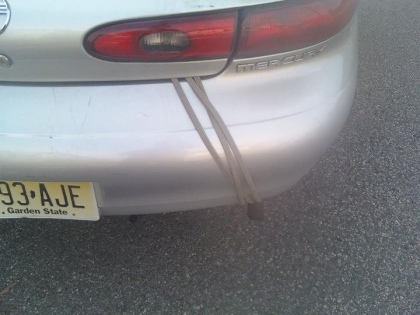via Karen Barbé

She says:
I hate to see this bowl in pieces. It belonged to my great-grandmother and I’ve never been able to fix it. After a while, all types of adhesives I’ve tried end up drying and crackling and the bowl splits up again. It seems they are not made for each other anymore.
Filed under: architecture, ceramic | Tags: Busted, missing, patched, replaced

This image was posted to Facebook by Brian McCorkle in March. I asked him twice where it was taken, and he wouldn’t tell me.
Love the half-attempt to match the pattern of the original tiles.
Also, this looks like a portal into another universe.
Text and images below are reposted from Uppsala University Library’s website.
———————
The manuscript dates from the 14th century and it belonged to the monastic library at Vadstena Convent after its purchase in Konstanz in 1417.

The pages of the book are made of parchment and they show typical damage in the form of holes and tears that happened while the parchment was being made. Some time after the book was copied, the holes and tears have been mended artistically with silk of various colours, mainly in blanket stitch as used in embroidery.
The old mending is in good shape except for those parts which were sewn with black silk. The thread is so fragile that it disintegrates on touch.

During the project the black thread was subjected to colour analysis to find out which colouring agents had been used. The results showed that the black dye had been made with iron sulphate and tannin, which implies that the thread was dyed with iron filings and various plants that contain the tanning agent tannin e.g. oak apple and sumac leaves. The whole dyeing process is very acidic and if the wrong proportions of tannin and iron salt are used, sulphuric acid forms considerably accelerating the natural decomposition of the thread or material. In order to prevent the black parts disappearing completely they were treated with a glue that was applied as a spray mist. Some parts were stabilised with a thin silk gauze.

Since the conservation process the book can be handled without the breaking the black thread but it still has to be treated very gently with the respect due to a book of its age.

With decorative duct-tape, by Heather Hart. Heather works with gold leaf a lot, to reference a kind of alchemy. Looks like she’s transforming herself!
Below: The Numinous Negro, 2010

Hey Anne, do you still have your blog about repairs? I fixed my shoe.
Hey Allan! Thank you for the photo! I will post it. What happened to your shoe? I have kept Repaired Things going, but just barely.
It’s what happens will all my shoes, the inside of the back of the heel came undone. And all the shops were like, “Oh, we can’t fix that. You have to stop kicking your shoes off.” Scolding me! So there was this flap of shoe hanging around the inside, so I sewed that very crude patch on.
There are plenty of people in India who will fix things like that. Our cobblers are just lazy.
Besides, it is worth it in the long run. We are just externalizing the costs of producing cheap goods; the costs are there in environmental harm and human rights abuses; we just don’t see them. So if I want to not hurt anyone with the things I wear, it might be cheaper to pay $20 for my things to be repaired rather than buy expensive new free trade / organic shoes.













